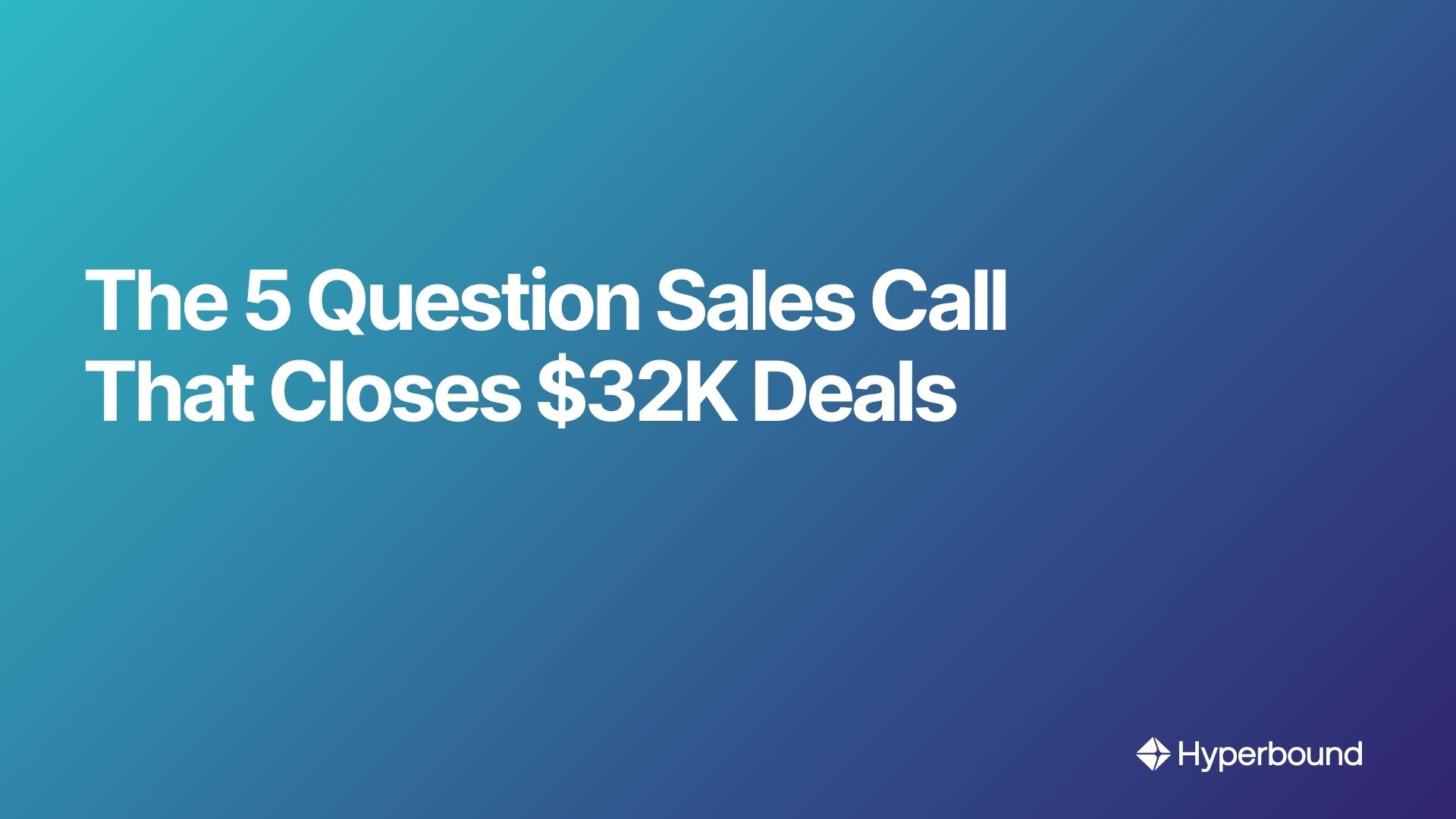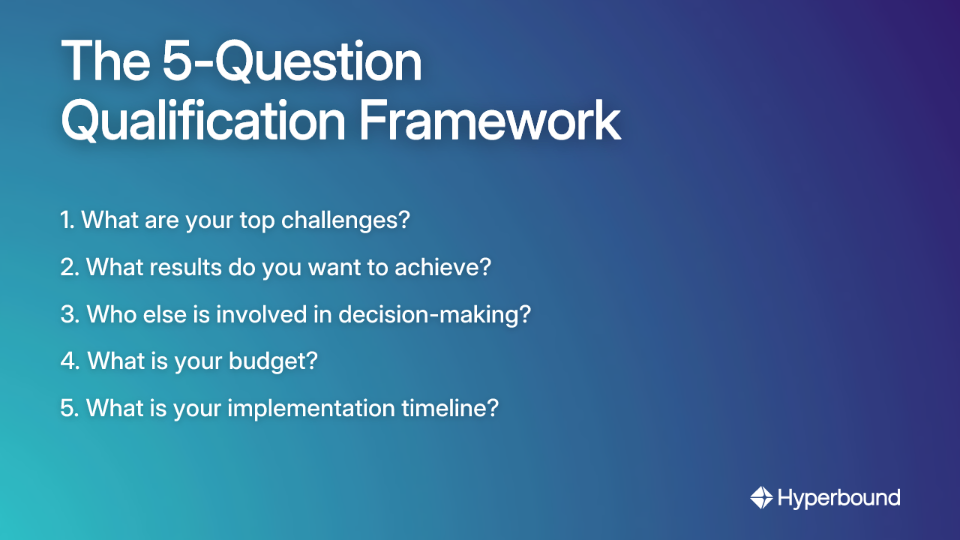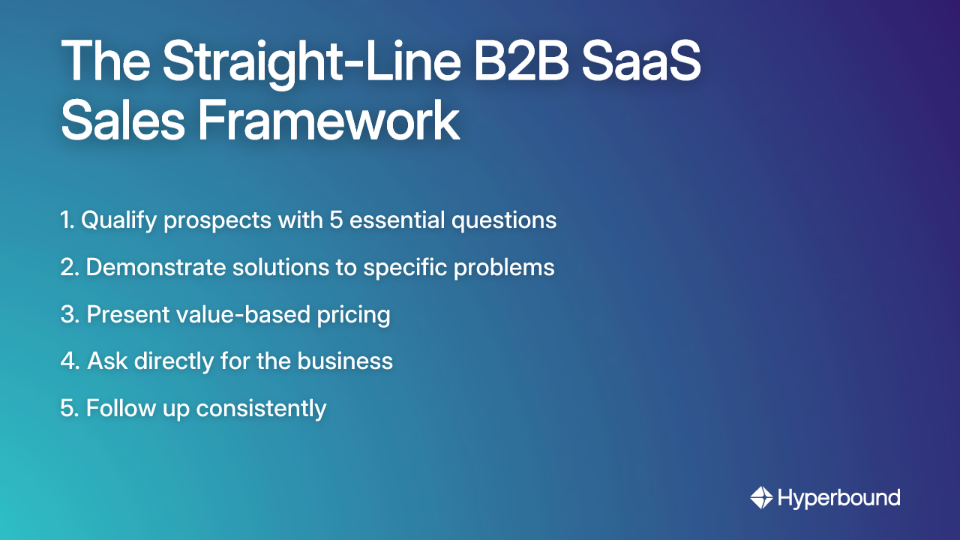
You've probably been told that selling big-ticket B2B SaaS solutions requires building extensive rapports, asking dozens of discovery questions, and mastering complex objection handling techniques.
But what if everything you've been taught about enterprise sales is wrong?
After analyzing hundreds of successful sales calls—a process now automated by AI platforms like Hyperbound—I've discovered something shocking: top performers aren't following the conventional playbook. They're taking a direct "straight line" approach that closes $32K+ deals with remarkable efficiency.
The B2B SaaS market is projected to grow from $197 billion in 2023 to $232 billion by 2024 according to recent industry analysis. With stakes this high, it's time to abandon outdated methodologies and embrace what actually works.
The Truth About High-Performance B2B Sales
Here's what top salespeople understand that average performers don't: the quality of leads is way more important than anything else.
As one industry veteran observed on Reddit: "The deals that close just don't seem to have objections... these customers were perfect fits and were in market."
When you target ideal prospects who are already searching for solutions like yours, the entire sales process transforms. You don't need manipulative tactics or endless qualification calls. You simply need to confirm they're a good fit and demonstrate your solution efficiently.
Let me show you exactly how this works.
Part 1: The 5-Question Qualification Framework That Filters for Gold
The best B2B SaaS salespeople don't waste time with lengthy discovery sessions. With sales cycles lasting one to six months, filtering out poor-fit prospects early is critical.
Effective qualification is about asking the right questions, not the most questions. Top performers typically ask fewer than five targeted questions to determine if a prospect is worth pursuing.
Here are the only five questions you need:

Question 1: "What are the top challenges your company is currently facing?"
This immediately uncovers whether your solution can address their pain points. It's diagnostic rather than "salesy," allowing the prospect to openly share their situation.
Question 2: "What results do you want to achieve with a solution?"
This shifts the conversation from features to outcomes. Understanding their desired results helps you position your solution as the bridge between their current struggles and future success.
Question 3: "Who else, besides yourself, is involved in the decision-making process?"
This question identifies all decision makers early to prevent late-stage surprises. Interestingly, top salespeople "treated every person like they were the decision maker," which builds trust and empowers their contact, as noted by sales professionals.
Question 4: "What is your budget for solving this problem?"
This direct question ensures financial viability. Avoiding budget discussions wastes everyone's time on deals that can't happen. Top performers aren't afraid to discuss money early.
Question 5: "What is your timeline for implementation?"
This gauges urgency and seriousness. A clear timeline indicates they're ready to move forward, not just "exploring options."
What's critical here isn't just the questions themselves but your tone of voice. As one sales leader observed: "It wasn't the questions that annoyed people, it was the way the sales person asked it."
Delivery should be consultative and confident—like a doctor diagnosing an illness—not interrogative or desperate. This is where practice becomes crucial. AI-powered roleplay platforms like Hyperbound allow reps to hone their tone and delivery in realistic scenarios until it becomes second nature.
Part 2: The High-Impact Demo: From "Feature Dumping" to Problem Solving
The conventional wisdom says your demo should be highly customized with extensive discovery beforehand. Yet surprisingly, top performers often engage in what can only be described as "feature dumping"—a straightforward presentation of capabilities without excessive personalization.
Why does this work? Because when you've properly qualified the prospect, you're showing solutions to someone who already recognizes their problem and believes you might be able to solve it.
However, there's a critical difference between effective feature presentations and confusing product tours. Here's the 3-step demo structure that consistently works for big ticket sales:

Step 1: Summarize the Diagnosis
Begin by restating the top 2-3 pain points identified in your qualification call:
"Based on our conversation, it sounds like your biggest challenges are tracking customer engagement across multiple channels, integrating with your existing tech stack, and generating actionable analytics. Is that accurate?"
This immediately centers the demo on their needs, not your product.
Step 2: Set the Stage
Present a clean screen and orient the customer:
"I'm going to show you exactly how our platform solves these specific challenges. We'll focus on the three areas that matter most to your situation."
This frames everything that follows as a solution to their problems, not a generic tour.
Step 3: Show the Solution in Their Context
This is where many salespeople go wrong with excessive feature dumping. Instead, a best practice is to connect every feature directly back to one of their pain points:
"This dashboard solves your visibility problem by consolidating data from all channels into one view. Your team can see real-time engagement metrics without switching between systems."
Throughout the demo, maintain engagement with simple confirmation questions:
"Can you see how this would help your team track customer interactions across departments?"
Part 3: The Simple Pricing Presentation That Closes the Deal
A 2021 survey found that only 39% of SaaS companies use value-based pricing, according to Stripe's research. This is a massive missed opportunity.
The most effective pricing presentations follow three principles:
1. Align Price with Value
Explicitly connect the cost to the outcomes discussed:
"Based on the challenges we've discussed, implementing our Enterprise solution would eliminate the 5 hours per week your team currently spends manually consolidating reports. At your current labor costs, that's approximately $25,000 in savings annually, not including the revenue benefits of faster decision-making. The investment for this solution is $32,000 per year."
2. Offer Simple, Clear Options
Use a tiered or per-user pricing model that gives the customer choice without complexity:
"We have three options that might work for your situation: Standard at $24,000/year, Professional at $32,000/year, or Enterprise at $48,000/year. Based on your specific needs around multi-department access and custom reporting, the Professional plan offers the best balance of functionality and value."
3. Use Social Proof
Justify the cost by mentioning success stories from similar clients:
"Companies like ABC Corp implemented this same solution last quarter and saw a 34% improvement in customer retention within the first 90 days."
The Direct Close
Now for the critical moment that separates average performers from top closers. According to sales professionals on Reddit, many salespeople end with weak closing tactics like "What are your thoughts?" instead of directly asking for the business.
Instead, use this direct approach:
"Based on everything we've discussed, the Professional Plan at $32,000 is the best solution to address your team's challenges with customer tracking and reporting. Are you ready to move forward with implementation?"
This direct question demands a response and moves the conversation toward a decision.
Master the Fundamentals, Master the Sale
The "straight line" B2B SaaS sales process I've outlined works because it eliminates complexity and focuses on what truly matters:

- Quickly qualifying prospects with 5 essential questions
- Demonstrating your solution in the context of their specific problems
- Presenting pricing in terms of value and asking directly for the business
When you follow this framework with high-quality leads who are already in-market, major objection handling becomes largely unnecessary. As one sales leader noted, "the deals that close just don't seem to have them."
The final essential element is follow-up. Unfortunately, many salespeople neglect this critical step. Send an immediate summary email with next steps after each call, then follow up 2-3 days later to maintain momentum.
To ensure your process is working, track key metrics like Conversion Rates, Customer Lifetime Value (CLV), and Churn Rate. These metrics will confirm that your streamlined approach is delivering real business results.
Remember: In B2B SaaS sales, simplicity and focus win. The greatest salespeople aren't the ones with the most complex techniques—they're the ones who execute the fundamentals flawlessly with the right prospects.
Now go close some deals.
Frequently Asked Questions
What is the core principle of the straight-line B2B SaaS sales method?
The core principle is that focusing on high-quality, in-market leads is more critical than complex sales techniques. This approach streamlines the sales process by prioritizing prospects who already have a recognized need and are actively seeking a solution. Instead of relying on extensive rapport-building or objection handling, the straight-line method emphasizes efficient qualification, problem-focused demos, and a direct path to closing the deal.
Why is qualifying leads with just five questions effective for high-value deals?
Using just five targeted questions is effective because it quickly filters out poor-fit prospects, allowing salespeople to focus their time and energy on deals that are most likely to close. For high-value B2B SaaS deals with long sales cycles, efficiency is key. The 5-question framework—focusing on challenges, desired results, decision-makers, budget, and timeline—is designed to rapidly assess a prospect's viability, ensuring you only invest resources in opportunities with genuine potential.
How do top salespeople handle demos without extensive prior discovery?
Top salespeople deliver high-impact demos by first confirming the prospect's main challenges and then directly showing how specific features of their product solve those exact problems. This method isn't a random "feature dump"; it's a highly focused presentation. By summarizing their pain points and framing every feature as a direct solution, you keep the demo relevant and demonstrate immense value without needing weeks of prior discovery.
What should I do if a prospect resists discussing the budget early?
If a prospect is hesitant to discuss budget, frame the question in terms of value and potential return on investment (ROI) to make the conversation less about cost and more about solving their problem. You can say, "To ensure I'm recommending a solution that makes financial sense, it helps to know the budget range you've allocated." A strong refusal to discuss finances, however, can be a red flag that they are not a serious, qualified buyer.
What makes this approach different from traditional enterprise sales methods?
This approach differs from traditional methods by prioritizing lead quality and sales process efficiency over complex, time-consuming techniques. Traditional enterprise sales often assumes the salesperson must "create" the need or persuade a skeptical buyer through a long process. This straight-line method assumes you are talking to pre-qualified, in-market buyers, replacing lengthy discovery and persuasion tactics with direct, value-based presentations.
Is this sales approach suitable for all B2B SaaS products?
This streamlined sales approach is most effective for high-value, big-ticket B2B SaaS solutions where the target customers are well-defined and likely to be actively searching for a solution. It relies on a steady stream of high-quality leads. For lower-priced products or entirely new market categories where prospects are unaware of the problem, a different, more educational approach might be necessary.
How can I improve my team's delivery and tone for these conversations?
Improving delivery and tone requires consistent practice in a realistic, low-stakes environment. The way you ask questions is as important as what you ask, as a consultative and confident tone builds trust. AI-powered sales roleplay platforms like Hyperbound are designed for this, allowing reps to practice their qualification, demo, and closing statements until their delivery becomes natural and effective.

Book a demo with Hyperbound
.png)













